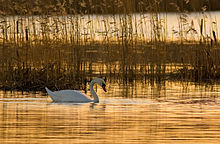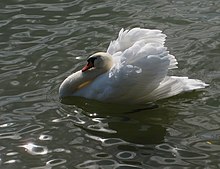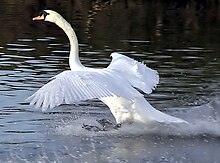Mute swan
| Mute Swan | |
|---|---|

| |
| Scientific classification | |
| Kingdom: | |
| Phylum: | |
| Class: | |
| Order: | |
| Family: | |
| Genus: | |
| Species: | C. olor
|
| Binomial name | |
| Cygnus olor | |
| Synonyms | |
| |
The Mute Swan (Cygnus olor) is a Eurasian member of the duck, goose and swan family Anatidae. Although they tend to be quieter than other kinds of swans, they are not mute, and do vocalize.
Taxonomy
The Mute Swan was first described by German naturalist Johann Friedrich Gmelin in 1789. Both cygnus and olor mean "swan" in Latin; cygnus is related to the Greek kyknos.[1][2] However, until the 1930s when the American Ornithologists' Union changed the species name, it was known as Sthenelides olor, confusing some record keeping and researchers. For example, most of the work done by Hildegard Howard at the California Museum of Natural History refers to the Mute Swan as Sthenelides olor. However, her earlier work referred to Cygnus olor, or simply Mute Swan, in identifications.
There are no recognized living subspecies of the Mute Swan. The morph immutabilis ("Poland Swan"), in which the cygnets are dull white, is not a subspecies because it occurs in all populations.
Evolution
Mute swan subfossils, 6,000 yrs old, are found in post-glacial peat beds of East Anglia, Great Britain.[3] They have also been recorded from Ireland east to Portugal and Italy,[4] and from France, 13,000 BP (Desbrosse and Mourer-Chauvire 1972-1973). Fossils of Mute Swan ancestors have been found in four US states: California, Arizona, Idaho and Oregon.[5] The timeline runs from the Miocene to the late Pleistocene, or 10,000 BP. The latest find was in Anza Borrego Desert, a national park in California.[5]
E.C. Peilou, the Canadian expert on the Ice Age and animals that came across Bering Strait, has suggested that the fossilized mute swans did not become extinct; rather, like the Trumpeters did, they continued to live in small numbers in very remote areas.
The presence of Mute Swans in James Bay, Canada, prior to European colonization is shown by a specimen shot, in all probability, by market hunters in the mid to late 1600s.[6]

Fossils from the Pleistocene include Cygnus paloregonus from Fossil Lake, Oregon, Froman's Ferry, Idaho, and Arizona, referred to by Howard in Waterfowl of the World pp. 262-265 as "probably the mute type swan". Paleosubspecies Cygnus olor bergmanni, which differed only in size from the living bird, is known from fossils found in Azerbaijan.
The largest Mute Swans are found in the Caspian Sea area, on migration,[7] even into the present.
Description



Adults of this large swan range from 125 to 170 cm (49-67 in) long with a 200-240 cm (79-95 in) wingspan. They may stand over 1.2 m (4 ft) tall on land. Males are larger than females and have a larger knob on their bill.
The Mute Swan is one of the heaviest flying birds, with males (known as cobs) averaging about 12 kg (27 lbs) and females (known as "pens") more than 8 kg (19 lbs). An unusually big Polish cob weighed almost 23 kg (50 lbs), surpassing the longer-bodied Trumpeter Swan to make it the heaviest waterfowl ever recorded. Its size, orange-reddish bill and white plumage make this swan almost unmistakable at close quarters. Surveys done by airplane, however, often mistake the species, creating questionable counts. The most similar species is the Whooper Swan, but it has a yellow and black bill, lacks the curved "swan" neck, is longer and heavier, and lacks the characteristic projection above the bill.
Young birds, called cygnets, are not the bright white of mature adults, and their bill is black, not orange, for the first year. The color of the down may range from pure white to grey to a buff color. The grey/buff coloration is most common. The white colored cygnets have a leucistic gene, seen most often in the north central states in America and in Poland. All Mute Swans are white at maturity.
Distribution and Habitat

This species of bird is found naturally mainly in temperate areas of Europe across western Asia, as far east as the Russian maritimes, near Sidemi.[8] Gmelin (1789) and John Latham (1824)[7] reported Mute Swans present in Kamchatka in the 1700s and still nesting there in 2007. Heilprin recorded Mute Swans arriving in Alaska across the Bering Strait.[9]
It is migratory throughout northern latitudes in Europe and Asia, as far south as north Africa and in the Mediterranean. It is known and recorded to have nested in Iceland and is a vagrant to that area, as well as to Bermuda, according to the U.N. Environmental Programme chart of international status chart of bird species, which places it in seventy countries.
Population in the United States of America
Mute Swans were introduced to the United States in the late 1800s primarily for their ornamental value. Recently this swan has been widely viewed as an invasive species because of its rapidly increasing numbers and impacts on other waterfowl and native ecosystems. For example, a study of population sizes in the lower Great Lakes from 1971 to 2000 found that Mute Swan numbers were increasing at an average rate of at least 10% per year, doubling the population every 7 to 8 years.[10] Several studies have concluded that Mute Swans severely reduce densities of submerged vegetation where they occur.[11]
In 2003 the U.S. Fish and Wildlife Service proposed to "minimize environmental damages attributed to mute swans" by reducing their numbers in the Atlantic Flyway to pre-1986 levels, a 67% reduction at the time. According to the 2003 Federal Register[12] the proposal was supported by all thirteen state wildlife agencies which submitted comments as well as by 43 bird conservation, wildlife conservation and wildlife management organizations. Ten animal rights organizations and the vast majority of comments from individuals were opposed. At this time Mute Swans were protected under the Migratory Bird Treaty Act due to a court order, but in 2005 the Department of the Interior officially declared them a non-native, unprotected species.[13] Mute Swans are protected in some areas of the U.S. by local laws, as for example in Connecticut.
World population

The population of Mute Swans in the United Kingdom is believed to be about 25,000, as of 2006. In Ireland there are about 10,000 pairs. In Russia/Siberia it has gone through many population fluctuations due to human activities, including wars and starvation. The most recent numbers are estimated in the hundreds of thousands; however, some of these may be mistakenly identified as Mute Swans when they are instead the Whooper Swan, Bewick's Swan, or Tundra Swan, which are also found wild there.
The UN Environmental Programme lists Cygnus olor (Mute Swan) as found in 70 countries, breeding in 49 countries, and vagrant in 16 countries. While thought to have been "introduced" in Japan, recent discoveries of Mute Swans depicted on scrolls more than a thousand years old put that statement into question. Natural migrations to Japan have been recorded, and Mute Swans continue to migrate to Japan in winter, along with Whooper and sometimes Bewick's Swans.
This species is often kept in captivity outside its natural range, as a decoration for parks and ponds, and escapes have happened. The descendants of such birds have become naturalised in the eastern United States and Great Lakes, much as the Canada Goose has done in Europe. The total number of Mute Swans in North America has never gone beyond 16,000 (U.S. Fish and Wildlife letter to Federal register 2004), but they have been classified as pests in some areas due to potential competition with native species.
Behavior
Mute Swans nest on large mounds that they build in shallow water in the middle or at the very edge of a lake. These monogamous birds reuse the same nest each year, restoring or rebuilding it as needed. Male and female swans share the care of the nest, and once the cygnets are fledged it is not uncommon to see whole families looking for food. They feed on submerged aquatic vegetation, reached with their long necks. This bird can often be found in colonies of over 100 individuals such as at the southern tip of Öland Island, Ottenby Preserve, in the coastal waters of the Baltic Sea.[14] These large groups are generally non-mated juveniles.[15] Once the adults are mated they seek out their own territories and often live close to ducks and gulls, who take advantage of the swan's ability to reach weeds, which tend to spread out on the water surface.

Although this bird can be tame, especially to those who feed it daily, it is aggressive in defence of its nest, and its size and impressive hissing make it a formidable adversary for animals as large as a fox. Large waterfowl, such as Canada Geese may be driven off, and there have been many reports of Mute Swans attacking people who enter their territory. The male (Cob) is also responsible for defending the cygnets while on the water, and will sometimes attack small watercraft, such as jet skis or canoes, that it feels are a threat to its young. The Cob will also try and chase the predator out of his family territory, and will keep animals such as Foxes and birds at bay.
The Mute Swan is less vocal than the noisy Whooper and Bewick's Swans; the most familiar sound associated with Mute Swan is the whooshing of the wings in flight once this bird has laboriously taken off from the water. This sound, peculiar to the species, was noted by James Audubon in his Birds of North America, in the section on swans, where he stated that he "would accept the possibility of another swan species on the American continent" in addition to the Trumpeter and Tundra swans.
The phrase swan song refers to this swan and to the legend that it is utterly silent until the last moment of its life, and then sings one achingly beautiful song just before dying; in reality, the Mute Swan is not completely silent, but has a kind of guttural warning call it will give when approached.
Unlike Black Swans, Mute Swans are strongly territorial. The familiar pose with neck curved back and wings half raised, known as busking, is a male threat display. The Mute Swan is protected in most of its range, but this has not prevented illegal hunting and poaching. Mute Swans, while called mute, do sometimes make grunting, clicking, barking and snorting noises, especially in the training of their cygnets, and usually hiss to predators trying to enter their territory. Black Swans and Whooper Swans are less aggressive and are not as defensive against predators. Trumpeter Swans will sometimes leave their nests if threatened. Mute Swans will attack land animals in defense of their families, during the period before fledging of their offspring (which, at six months, is longer than that of most other birds).
In culture



- A Mute Swan was shown on the official Euro during 2005 when the Union was headed by the President of Ireland.
- Socrates' last words before being put to death in 399 BC: "You think I cannot see as far ahead as a swan. You know that when swans feel the approach of death they sing, and they sing sweeter and louder on the last days of their lives because they are going back to that God whom they serve." (Plato)
- The Mute Swan is the national bird of the Kingdom of Denmark.
- The fairy tale The Ugly Duckling by Hans Christian Andersen tells the story of a cygnet ostracized by his fellow barnyard fowl because of his perceived homeliness. To his delight (and to the surprise of others), he matures into a graceful swan, the most beautiful bird of all.
- Today, the Crown (the British monarch) retains the right to ownership of all unmarked mute swans in open water, but the Queen only exercises her ownership on certain stretches of the Thames and its surrounding tributaries. This ownership is shared with the Vintners' and Dyers' Companies, who were granted rights of ownership by the Crown in the fifteenth century. See Swan upping.
- The Mute Swans in the moat at the Bishops Palace at Wells Cathedral in Wells, England have for centuries been trained to ring bells via strings attached to them to beg for food. Two Swans are still able to ring for lunch. Bell Ringing Swans Of Wells, England Official Website
- There is rich iconic and literary evidence for Celtic bird-goddesses who took the form of swans. Similarly, swans are highly revered in Hinduism (see the culture section of swan). The Roman Julius Caesar noted that the British tribes thought wild geese and swans "unlawful" to eat or kill. By medieval times, though, swans were considered an edible form of poultry. Nowadays they are a protected species in many countries.
References
- ^ Liddell, Henry George and Robert Scott (1980). A Greek-English Lexicon (Abridged Edition). United Kingdom: Oxford University Press. ISBN 0-19-910207-4.
- ^ Simpson, D.P. (1979). Cassell's Latin Dictionary (5 ed.). London: Cassell Ltd. p. 883. ISBN 0-304-52257-0.
- ^ Northcote, EM (1981). "Size difference between limb bones of recent and subfossil Mute Swans (Cygnus olor)". J. Archeol.Sci. 8: 89–98.
- ^ Palmer, RS (1976). Handbook of North American Birds, vol.2. New haven: Yale University Press.
- ^ a b Jefferson, GT (2005). Fossil Treasures of the Anza-Borrego Desert. pp. p. 153.
{{cite book}}:|pages=has extra text (help) - ^ Sadler, D (2003). Birds from the ground; the record of archaeology in Ontario. Trent University Press.
{{cite book}}: Unknown parameter|coauthors=ignored (|author=suggested) (help) - ^ a b Latham, John (1824). General History of Birds. ISBN pages=220-223.
{{cite book}}: Check|isbn=value: invalid character (help); Missing pipe in:|isbn=(help) - ^ Dement'ev, G.P. (1967). Birds of the Soviet Union (US Fish & Wildlife Translation) vol. IV.
{{cite book}}: Unknown parameter|coauthors=ignored (|author=suggested) (help) - ^ Heilprin, J (2007-1-23). "Majestic swans flying across the Bering Strait into Alaska". Associated Press.
{{cite news}}: Check date values in:|date=(help) - ^ http://cat.inist.fr/?aModele=afficheN&cpsidt=14981898 Rapid increase in the lower Great Lakes population of feral mute swans: a review and a recommendation
- ^ Allin, Charles C. and Husband, Thomas P. (2003). "MUTE SWAN (CYGNUS OLOR) IMPACT ON SUBMERGED AQUATIC VEGETATION AND MACROINVERTEBRATES IN A RHODE ISLAND COASTAL POND". Northeastern Naturalist. 10 (3): 305–318.
{{cite journal}}: Unknown parameter|month=ignored (help)CS1 maint: multiple names: authors list (link) - ^ http://frwebgate3.access.gpo.gov/cgi-bin/TEXTgate.cgi?WAISdocID=07972632218+0+1+0&WAISaction=retrieve Finding of No Significant Impact and Final Environmental Assessment for the Management of Mute Swans in the Atlantic Flyway
- ^ http://frwebgate3.access.gpo.gov/cgi-bin/TEXTgate.cgi?WAISdocID=07972632218+0+1+0&WAISaction=retrieve Final List of Bird Species to Which the Migratory Bird Treaty Act Does Not Apply
- ^ Hogan CM (2006). Environmental Database for Oland, Sweden. Lumina Press.
{{cite book}}: Cite has empty unknown parameter:|1=(help) - ^ Scott, P. and the Wildfowl Trust. Behavioral patterns of juvenile Mute Swans. 1972.
- Allin, C. C., & Husband, T. P. (2003). Mute swan (Cygnus olor) impact on submerged aquatic vegetation and macroinvertebrates in a Rhode Island coastal pond. Northeastern Naturalist, 10, 305-318.
- Template:IUCN2006 Database entry includes justification for why this species is of least concern
- Connecticut State Statutes, (2005). Protection of the Mute Swan species.
- Dement'ev, G.P. & Gladkov, N.A. (1967). USF&W translation of Birds of the Soviet Union, Vol.IV.
- Heilprin, J. "Majestic swans flying across the Bering Strait into Alaska." Associated Press (1/23/2007).
- Latham, John, M.D. (1824). General History of Birds. 220-223.
- Library of Congress.(1926). Removal of Phosphorous in Chesapeake Bay Where Ducks Feed.
- Madge, S. and Burn, H. (1987). Wildfowl: An Identification Guide to the Ducks, Geese and Swans of the World. A & C Black. ISBN 0-7470-2201-1.
{{cite book}}: CS1 maint: multiple names: authors list (link) - Parrott, D., & McKay, H. V. (2001). Mute swan grazing on winter crops: Estimation of yield loss in oilseed rape and wheat. Crop Protection, 20, 913-919.
- Pennant, Thomas. (1792) Arctic Zoology, Vol.II, Class II, Printed for Rbt Faulder, London. 262-265.
- Ticehurst, N. E. (1957). The mute swan in England. London: Cleaver-Hume Press.
- U.S. Fish & Wildlife Flyway Reports (2005). Population numbers on the Mute Swan species.
- Wilmore, S.B. (1979). Swans of the World" (pp. 29-35, 44-75).
- RSPB Handbook of British Birds, Second Edition (2006) P. 11
External links
- ARKive – images and movies of the mute swan (Cygnus olor)
- The Bell Ringing Mute Swans Of Wells
- Cathedral Swan Pool – image from the Postcard Collection at www.somerset.gov.uk
- Swan Ringing a Bell – image from the Postcard Collection at www.somerset.gov.uk
- Swans Ring Bells – image from the Postcard Collection at www.somerset.gov.uk
- The Mute Swan – written by Sylvia Roff-Marsh and hosted at tintota.com
- RSPB Mute Swan Page
- Mute Swan Information and Photos – South Dakota Birds and Birding
- Mute Swan – Cornell Lab of Ornithology
- Mute Swan videos on the Internet Bird Collection
- Massachusetts Breeding Bird Atlas
- British Monarchy website Regarding Swan Upping and The Crown's ownership of Mute Swans.
- Articles needing cleanup from September 2007
- Cleanup tagged articles without a reason field from September 2007
- Wikipedia pages needing cleanup from September 2007
- IUCN Red List least concern species
- Birds of Europe
- Birds of Turkey
- Birds of Lithuania
- Birds of Pakistan
- Cygnus
- Swans
- Introduced birds
- Invasive animal species
- British Isles coastal fauna
- Megafauna of Eurasia

